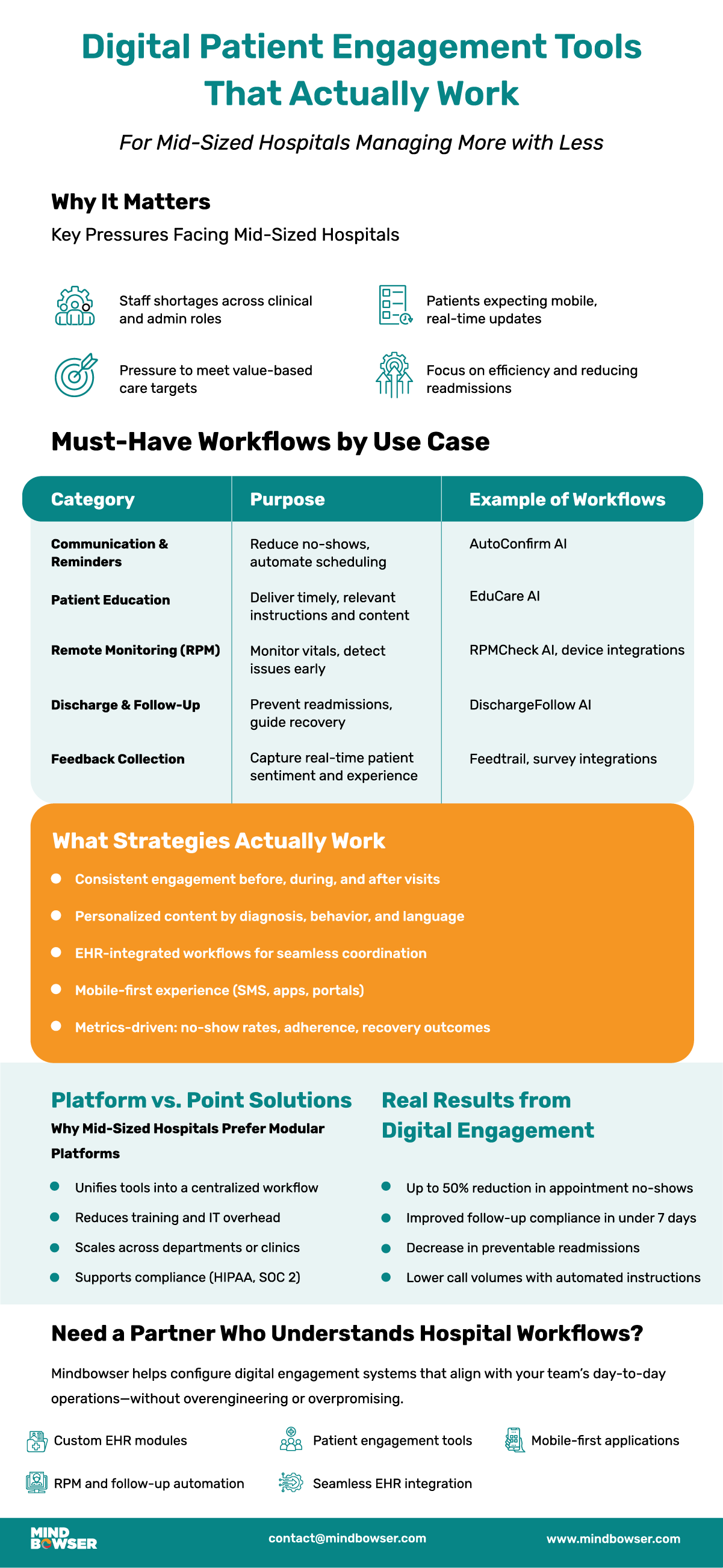When we discuss digital patient engagement tools, we refer to the software and systems that hospitals utilize to connect with patients beyond the clinic’s four walls. These tools support appointment scheduling, send reminders, deliver education, capture feedback, remotely monitor vitals, and help guide patients through each step of their care journey. At a broader level, a digital patient engagement platform brings all these capabilities into a centralized hub, integrating with existing EHRs, mobile apps, and care workflows.
For mid-sized hospitals, digital patient engagement is no longer a future initiative—it’s a present-day necessity. Staffing shortages are widespread, patient expectations are rising, and reimbursement models are shifting toward outcomes and experience. Hospitals that once relied on printed instructions, outbound calls, and patchwork portals are now looking for scalable, consistent ways to stay connected with their patients before, during, and after visits.
This blog outlines the digital patient engagement tools and strategies that are delivering measurable value today. Whether it’s improving follow-up adherence, reducing no-show rates, or supporting care transitions, these systems help hospitals strengthen relationships and streamline operations without overwhelming their clinical staff.
Let’s explore how mid-sized hospitals are using technology to solve everyday challenges—and where to start if you’re ready to take a more modern, patient-centered approach to engagement.
Mid-sized hospitals—often operating with leaner budgets and leaner teams than large systems—are under growing pressure to do more with less. But doing more doesn’t always mean adding headcount. It increasingly means using the right digital patient engagement tools to fill operational gaps, streamline communication, and reduce avoidable workload for clinical and administrative staff.

Today’s patients expect more than just in-person visits. They expect reminders by text, results through their phone, and answers without waiting on hold. Whether they’re managing a chronic condition or recovering from surgery, patients want clear, timely, and personalized guidance. Hospitals that don’t meet these expectations risk lower satisfaction scores, missed appointments, and even disengaged patients who delay or abandon follow-up care.
For hospitals participating in value-based care programs, patient engagement isn’t a “nice to have”—it directly impacts financial performance. Measures tied to outcomes, readmissions, and patient-reported experiences, such as the Hospital Consumer Assessment of Healthcare Providers and Systems (HCAHPS), are increasingly being scrutinized by payers and regulators. Digital engagement tools help close those gaps by providing structured follow-ups, education, and reminders that encourage adherence and catch issues early.
Related read: Value-Based Health Care: Transitioning to a Model for Better Patient Health Outcomes
Staffing shortages are a reality across the board, particularly in nursing and care coordination. Hospitals can no longer rely solely on human touchpoints—there simply isn’t enough time or coverage. Digital patient engagement tools help automate routine tasks, such as appointment scheduling, symptom tracking, and post-discharge follow-ups. These tools allow care teams to focus their time where it’s needed most, while still maintaining a consistent patient experience.
One-off tools can be useful, but disconnected systems often create more work. That’s why many hospitals are now implementing a unified digital engagement platform. This system integrates communication, education, monitoring, and feedback into a single interface that synchronizes with the hospital’s EHR. This helps avoid duplication, reduces errors, and gives both clinicians and patients a single, clear channel for interaction.
Digital engagement only works when it meets patients where they are, without adding friction to hospital workflows. Below are the categories of digital patient engagement tools that mid-sized hospitals are successfully implementing today, along with specific examples tied to common use cases.
Engagement starts with communication. Whether it’s an appointment reminder or a follow-up message, patients expect timely, direct updates. Hospitals are increasingly using SMS, in-app messaging, and email to streamline communication, reducing no-shows and improving preparedness for visits.
Tools in Action:
Why It Works:
Centralizing communications within a digital engagement platform ensures consistency and reduces manual tasks, especially for teams managing multiple clinics or service lines.
Patients who understand their condition and care plan are more likely to follow through. Educational content—especially when personalized—can help reduce post-discharge confusion, prevent unnecessary calls to the nurse line, and foster trust.
Tools in Action:
Why It Works:
On-demand education, delivered through the same channel as appointment and follow-up messages, builds continuity and reinforces care plans without requiring additional staff time.
For chronic disease management or post-acute care monitoring, RPM enables hospitals to track vital signs and symptoms in real-time, catching complications early and reducing readmission risk.
Mindbowser In Action:
Why It Works:
Mid-sized hospitals often struggle to assign nurses to every patient post-discharge. RPM tools automate this coverage, surfacing only the cases that require attention.
The transition from hospital to home is a vulnerable point. Digital follow-up tools help close the loop by checking in with patients, guiding them through recovery, and escalating symptoms before they turn into complications.
Tools in Action:
Why It Works:
These tools ensure no patient falls through the cracks—especially helpful when clinical staff are stretched thin and discharge coordinators manage multiple departments.
Gathering patient feedback in real-time allows hospitals to identify service gaps early and improve experience scores. Instead of waiting for HCAHPS reports months later, teams can address issues on the same day.
Tools in Action:
Why It Works:
Quick feedback loops help address dissatisfaction, reinforce positive experiences, and identify trends across departments. These insights feed directly into quality improvement efforts.
Each of these tools plays a role in shaping a more responsive, accessible, and efficient care journey. When tied together through a hospital’s digital engagement platform, they reduce fragmentation and improve visibility for both patients and providers.
Implementing digital tools is just the start. To create a lasting impact, hospitals must pair those tools with strategies that align with clinical workflows and patient behavior. Here are key approaches that have proven effective in real-world hospital settings, particularly for mid-sized facilities that balance patient outcomes with operational efficiency.
Engagement isn’t a one-time message—it’s a continuum. Patients should feel supported from the moment they book an appointment to the point of recovery. Consistency is key. For example:
This continuity fosters trust and reduces the likelihood of patient drop-off or confusion for individuals managing chronic conditions or complex care plans.
A one-size-fits-all approach doesn’t hold up in today’s healthcare environment. Patients engage more when the content feels relevant to their specific situation.
These nuances are easily managed when built into a digital engagement platform with logic-driven workflows and templates.
Too often, engagement tools sit outside the clinical record, forcing double documentation or worse, creating blind spots. A seamless integration with your EHR ensures that every patient interaction—reminders, education, feedback—is logged in one place. This not only improves care coordination but also enhances documentation for regulatory and billing purposes.
HealthConnect CoPilot supports this kind of integration by aligning digital engagement workflows with major EHR systems using HL7 and FHIR standards.
Mobile isn’t a trend—it’s the default for most patients. Hospitals that rely on desktop portals alone miss opportunities to reach patients where they are.
The key is to design intuitive experiences with low friction and avoid requiring repeated logins or downloads.
Hospitals should measure more than message delivery or app downloads. Effective engagement strategies track meaningful outcomes:
When engagement is treated as part of the clinical workflow—not just a communications add-on—its impact becomes easier to measure and justify.
For mid-sized hospitals, investing in digital patient engagement tools isn’t just about adding new tech—it’s about filling operational gaps, enhancing patient experience, and supporting the care team without overextending resources. However, with numerous tools available on the market, it’s crucial to approach selection with clarity and purpose.
Start with a simple question: Where are we losing patients or creating friction today?
Identifying these pressure points helps narrow your focus to tools that address immediate, measurable problems. For example, if your front desk spends hours confirming appointments, a messaging automation tool should be a top priority.
Mid-sized hospitals often grow fast or stretch to serve a wide geographic or service area. That makes scalability essential. Choose solutions that can expand across departments, locations, or specialties without needing a complete overhaul.
Security is equally critical. Ensure that any system you consider meets HIPAA and SOC 2 requirements, has robust user access controls, and integrates securely with your existing IT infrastructure.
Lastly, don’t overlook the importance of vendor support. Ask:
Tools that check the compliance box but lack responsive support can become liabilities, especially when rolled out system-wide.
You don’t need off-the-shelf software dictating how your teams should operate. Instead, look for configurable solutions that can adapt to the way your clinicians and administrative staff already work.
This could mean customizing:
Point solutions solve narrow problems, but managing a dozen of them across departments can become chaotic. A modular digital engagement platform allows you to start small—with the most urgent tools—and add on as your needs evolve.
This approach is ideal for mid-sized hospitals because it strikes a balance between short-term gains and long-term strategy. You can pilot a messaging module in one clinic, then roll out RPM or education workflows system-wide when ready, all within a single, cohesive ecosystem.
At Mindbowser, we work closely with mid-sized hospitals to build and implement digital engagement systems that make sense clinically, operationally, and financially. Our approach is grounded in real-world constraints, including limited bandwidth, the need for interoperability, and the pressure to deliver results quickly.
Below are some of the key tools and systems we offer that help hospitals move from fragmented communication to coordinated, digital-first patient engagement.
AutoConfirm AI automates appointment confirmations, rescheduling, and day-of-visit instructions via SMS and email, eliminating the need for manual follow-up. This workflow helps reduce no-shows, alleviates pressure on front-desk teams, and ensures patients arrive informed and on time.
Hospitals use it to:
Patients often leave the hospital with a stack of paper and no clear idea of what happens next. DischargeFollow AI is a voice-based workflow that keeps hospitals connected with patients after they leave—automating check-ins, monitoring symptoms, and reinforcing recovery instructions. It helps hospitals maintain structured contact during the critical post-discharge window—checking in, flagging symptoms, and keeping recovery on track.
What it does:
RPMCheck AI: A Workflow for Scalable Remote Patient Monitoring. RPMCheck AI provides a structured approach to monitoring patients at home, whether they’re recovering from surgery or managing chronic conditions. Whether it’s post-surgical recovery or ongoing chronic care, it provides a framework for monitoring patients remotely, without overwhelming your nursing team.
How hospitals are using it:
EduCare AI: A Workflow for Timely Patient Education. It delivers personalized, condition-specific education to patients at critical moments, both before appointments and after procedures, and throughout their recovery. This workflow helps patients feel informed and confident in their care while reducing unnecessary callbacks, confusion, and missed instructions.
Core features include:
None of these tools lives in isolation. HealthConnect CoPilot ensures they work in sync with your hospital’s EHR—whether you’re using Epic EHR, Cerner EHR, Athenahealth EHR, or a custom system.
What it offers:
These are real implementations—designed for scalability, not just prototypes.

For mid-sized hospitals navigating staffing challenges, rising patient expectations, and pressure to deliver outcomes, the right digital patient engagement tools can create much-needed breathing room without compromising the quality of care.
This isn’t about chasing trends. It’s about solving real problems: missed appointments, gaps in discharge follow-up, patient confusion, and inconsistent communication. What works is a thoughtful blend of tools and strategy, built into a cohesive digital engagement platform that aligns with your workflows and scales with your growth.
At Mindbowser, we don’t believe in one-size-fits-all software. We collaborate with hospital teams to identify operational gaps and co-develop engagement systems that are clinically grounded, integration-ready, and outcomes-driven. Whether you need to streamline pre-visit communication, set up RPM programs, or automate post-discharge outreach, we can help bring it all together.
Next step: Let’s identify where your patient journey is breaking down—and explore how we can help you rebuild it using solutions that deliver value for your staff, your patients, and your bottom line.
Digital patient engagement tools are individual applications—such as appointment reminders, RPM dashboards, or educational modules—that address specific touchpoints in the care journey. A digital engagement platform brings these tools together into a centralized system that integrates with your EHR, making it easier for staff to manage and for patients to navigate.
Implementation timelines vary based on the complexity of your current systems and the tools you’re adopting. Many hospitals begin with one or two high-impact areas, such as communication or post-discharge follow-ups, and then expand from there. With the right partner, it’s possible to see results in weeks, not months.
Yes. The most effective engagement tools are designed with accessibility in mind. SMS-based workflows, simplified mobile interfaces, and multilingual content can help reach a broader patient population—including seniors—without requiring logins or app downloads.
By reducing no-shows, avoiding preventable readmissions, improving care compliance, and optimizing staff time, these tools directly contribute to both clinical and financial performance. They also help hospitals meet patient experience benchmarks tied to reimbursement and value-based care incentives.

We worked with Mindbowser on a design sprint, and their team did an awesome job. They really helped us shape the look and feel of our web app and gave us a clean, thoughtful design that our build team could...


The team at Mindbowser was highly professional, patient, and collaborative throughout our engagement. They struck the right balance between offering guidance and taking direction, which made the development process smooth. Although our project wasn’t related to healthcare, we clearly benefited...

Founder, Texas Ranch Security

Mindbowser played a crucial role in helping us bring everything together into a unified, cohesive product. Their commitment to industry-standard coding practices made an enormous difference, allowing developers to seamlessly transition in and out of the project without any confusion....

CEO, MarketsAI

I'm thrilled to be partnering with Mindbowser on our journey with TravelRite. The collaboration has been exceptional, and I’m truly grateful for the dedication and expertise the team has brought to the development process. Their commitment to our mission is...

Founder & CEO, TravelRite

The Mindbowser team's professionalism consistently impressed me. Their commitment to quality shone through in every aspect of the project. They truly went the extra mile, ensuring they understood our needs perfectly and were always willing to invest the time to...

CTO, New Day Therapeutics

I collaborated with Mindbowser for several years on a complex SaaS platform project. They took over a partially completed project and successfully transformed it into a fully functional and robust platform. Throughout the entire process, the quality of their work...

President, E.B. Carlson

Mindbowser and team are professional, talented and very responsive. They got us through a challenging situation with our IOT product successfully. They will be our go to dev team going forward.

Founder, Cascada

Amazing team to work with. Very responsive and very skilled in both front and backend engineering. Looking forward to our next project together.

Co-Founder, Emerge

The team is great to work with. Very professional, on task, and efficient.

Founder, PeriopMD

I can not express enough how pleased we are with the whole team. From the first call and meeting, they took our vision and ran with it. Communication was easy and everyone was flexible to our schedule. I’m excited to...

Founder, Seeke

We had very close go live timeline and Mindbowser team got us live a month before.

CEO, BuyNow WorldWide

Mindbowser brought in a team of skilled developers who were easy to work with and deeply committed to the project. If you're looking for reliable, high-quality development support, I’d absolutely recommend them.

Founder, Teach Reach

Mindbowser built both iOS and Android apps for Mindworks, that have stood the test of time. 5 years later they still function quite beautifully. Their team always met their objectives and I'm very happy with the end result. Thank you!

Founder, Mindworks

Mindbowser has delivered a much better quality product than our previous tech vendors. Our product is stable and passed Well Architected Framework Review from AWS.

CEO, PurpleAnt

I am happy to share that we got USD 10k in cloud credits courtesy of our friends at Mindbowser. Thank you Pravin and Ayush, this means a lot to us.

CTO, Shortlist

Mindbowser is one of the reasons that our app is successful. These guys have been a great team.

Founder & CEO, MangoMirror

Kudos for all your hard work and diligence on the Telehealth platform project. You made it possible.

CEO, ThriveHealth

Mindbowser helped us build an awesome iOS app to bring balance to people’s lives.

CEO, SMILINGMIND

They were a very responsive team! Extremely easy to communicate and work with!

Founder & CEO, TotTech

We’ve had very little-to-no hiccups at all—it’s been a really pleasurable experience.

Co-Founder, TEAM8s

Mindbowser was very helpful with explaining the development process and started quickly on the project.

Executive Director of Product Development, Innovation Lab

The greatest benefit we got from Mindbowser is the expertise. Their team has developed apps in all different industries with all types of social proofs.

Co-Founder, Vesica

Mindbowser is professional, efficient and thorough.

Consultant, XPRIZE

Very committed, they create beautiful apps and are very benevolent. They have brilliant Ideas.

Founder, S.T.A.R.S of Wellness

Mindbowser was great; they listened to us a lot and helped us hone in on the actual idea of the app. They had put together fantastic wireframes for us.

Co-Founder, Flat Earth

Mindbowser was incredibly responsive and understood exactly what I needed. They matched me with the perfect team member who not only grasped my vision but executed it flawlessly. The entire experience felt collaborative, efficient, and truly aligned with my goals.

Founder, Child Life On Call

The team from Mindbowser stayed on task, asked the right questions, and completed the required tasks in a timely fashion! Strong work team!

CEO, SDOH2Health LLC

Mindbowser was easy to work with and hit the ground running, immediately feeling like part of our team.

CEO, Stealth Startup

Mindbowser was an excellent partner in developing my fitness app. They were patient, attentive, & understood my business needs. The end product exceeded my expectations. Thrilled to share it globally.

Owner, Phalanx

Mindbowser's expertise in tech, process & mobile development made them our choice for our app. The team was dedicated to the process & delivered high-quality features on time. They also gave valuable industry advice. Highly recommend them for app development...

Co-Founder, Fox&Fork
